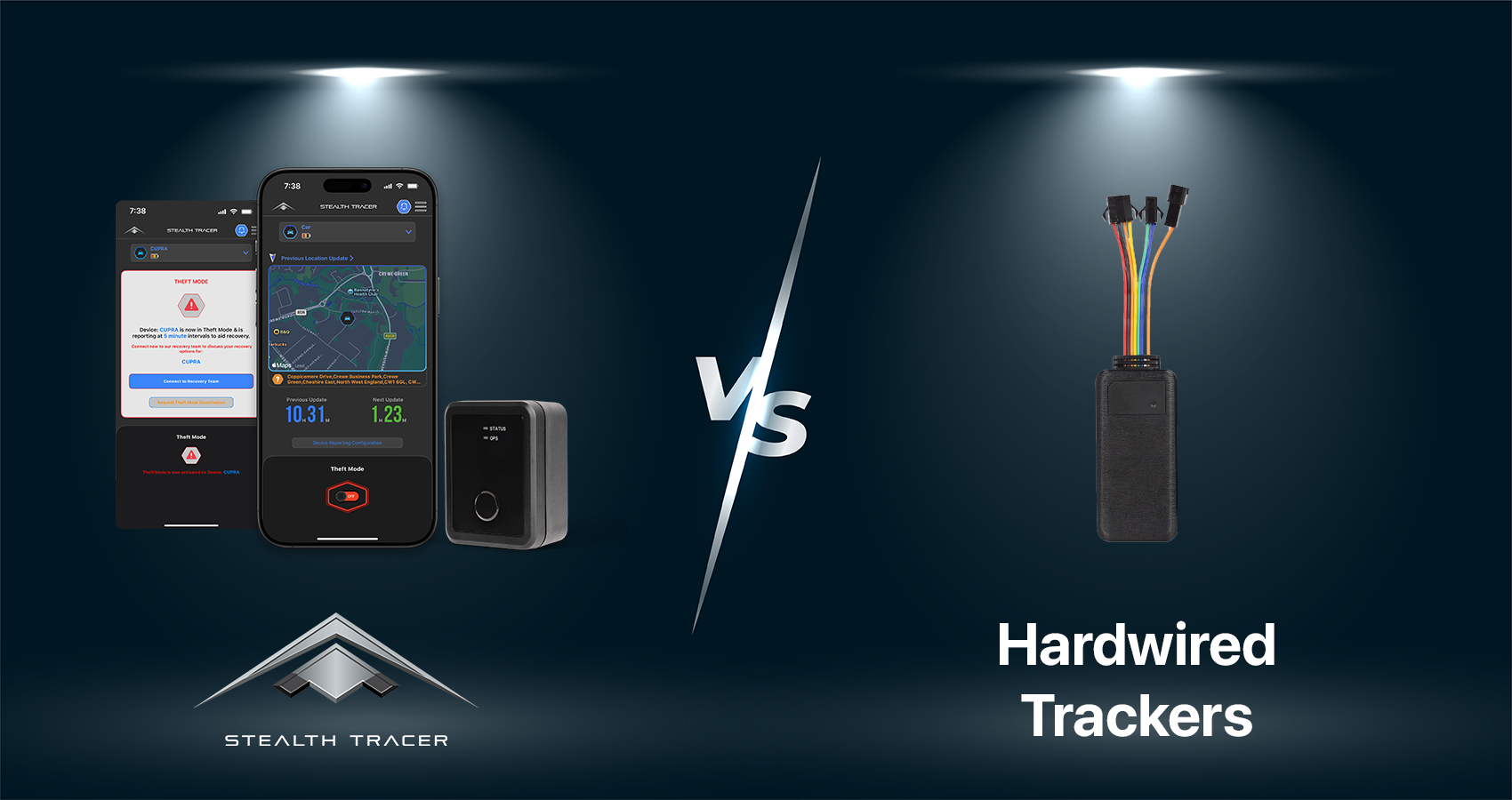Interval vs Hardwired Trackers: Choosing the Right Tracker for Real-World Theft Protection
When it comes to vehicle or asset security, not all trackers are created equal. Most people are familiar with conventional hardwired, professionally installed trackers: a unit hidden somewhere inside the vehicle, powered by the vehicle’s electrical system, constantly outputting a detectable GPS signal. But there’s another approach that focuses on increasing your chances of theft recovery - an interval-based tracker like Stealth Tracer.
Both forms of trackers have strengths and weaknesses. The real question is: which one gives you the best chance of recovery if the worst happens?
How Hardwired Trackers Work
A traditional tracker is hardwired into the vehicle and typically updates its location in real time or near real time. In theory, that means if your vehicle is stolen, you can see exactly where it is instantly.
Drawbacks
-
Installation requires a professional, specialised auto electrician, typically costing an additional £50-£150.
-
You risk voiding manufacturer warranties by tapping into vehicle wiring systems for power.
-
Almost always comes with a mandatory monthly subscription of £9–£18 for data usage and monitoring. Over a few years, this adds up to hundreds of pounds in running costs.
-
Limited to assets with a constant on-board power supply. Hardwired trackers aren’t an option for non-powered assets or older classic vehicles.
-
Live tracking means a constant GPS signal is output, making it easy for thieves to locate the tracker with widely available GPS scanning devices.
-
Predictable installation locations: since they must connect to the electrical system for power, thieves know exactly where to look to find & remove them.
- If the tracker is found and removed (which is increasingly common), your real-time advantage disappears instantly.
Strengths
-
Continuous connection with frequent updates, often true live tracking. Great if you need to keep an eye on driver behaviour.
-
Doesn’t rely on scheduled “wake-up” cycles.
-
No need to manage device battery life.
-
Can integrate with immobilisers or alarms in some cases.
How Interval-Based Trackers Work
Stealth Tracer takes a different approach known as interval tracking (with the option to track live when it matters). Instead of broadcasting a constant, easily detectable GPS signal day to day, the unit “wakes up” at set intervals to transmit its location. The rest of the time, it’s silent and virtually invisible to GPS scanning wands. This is until you actually require ‘live tracking’ - Theft Mode can be enabled in-app to provide our recovery team with more frequent locations for repatriation.
Strengths
-
Stealthy by design: no constant GPS signal, so it’s far harder to detect with scanning tools.
-
Can be installed almost anywhere in a vehicle or asset (GPS signal permitting).
-
Battery-powered: suitable for powered vehicles, non-powered assets, and vehicles with weak or outdated electrical systems (e.g. classic cars).
-
No professional install required: simple to fit yourself (while still retaining Thatcham S7 certification) and easy to move between assets.
-
Flat cost of £249 with no mandatory subscription fees — you own it outright, with no creeping monthly bills.
-
Low risk of detection by thieves means it’s working when you need it most.
- Still allows ‘live tracking’ when it matters most, through the 'Theft Mode’, enabled in the Stealth Tracer app.
Drawbacks
-
Less suitable for those who need second-by-second tracking (e.g. business fleet managers).
-
Relies more on good signal: GPS can be difficult to lock onto if the asset is underground or inside a building for example. If the device ‘wakes up’ to report its location in non-ideal signal locations, it may fail to get a location fix.
-
Increasing your reporting frequency drains the battery faster, forcing a trade-off between location update frequency & battery life.
-
Device command delay: if theft occurs just after a scheduled update, Theft Mode won’t activate until the device location next check-in.
- Batteries need to be replaced every 1–3 years.
The Key Trade-Off: Time vs Undetectability
It’s true - an interval-based system may mean you’re waiting minutes (or even hours, depending on your reporting settings) before Theft Mode kicks in. But here’s the crucial counterpoint: by the time that happens, there’s a high chance a hardwired tracker has already been located and ripped out by a professional thief.
The question is: would you rather have instant tracking that’s disabled within 10 minutes of a asset theft, or a slightly delayed ‘live tracking’ device that the thief never finds?
The Bottom Line
No tracker is perfect. Hardwired units offer immediacy, but they’re also a big, obvious target for any thief who half knows what they’re doing, and the monthly costs add up quickly. Interval-based trackers like Stealth Tracer trade a little speed for a high level of undetectability - the device keeps working without draining your wallet or your vehicle’s onboard battery.
That’s why more asset owners are turning to solutions like Stealth Tracer: simple to install, hard to detect, affordable to own & designed to keep working when others don’t. If you need a standalone theft-recovery-focused tracker, or a failsafe alongside your existing hardwired tracker, Stealth Tracer is the answer.


Share:
Stealth Tracer Featured in Powerboat & RIB